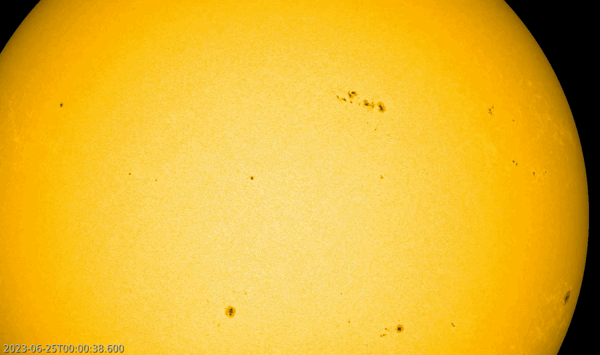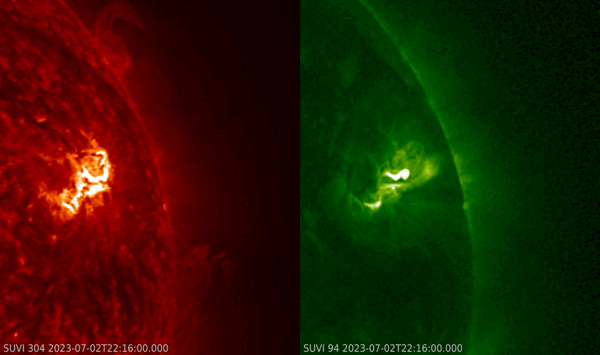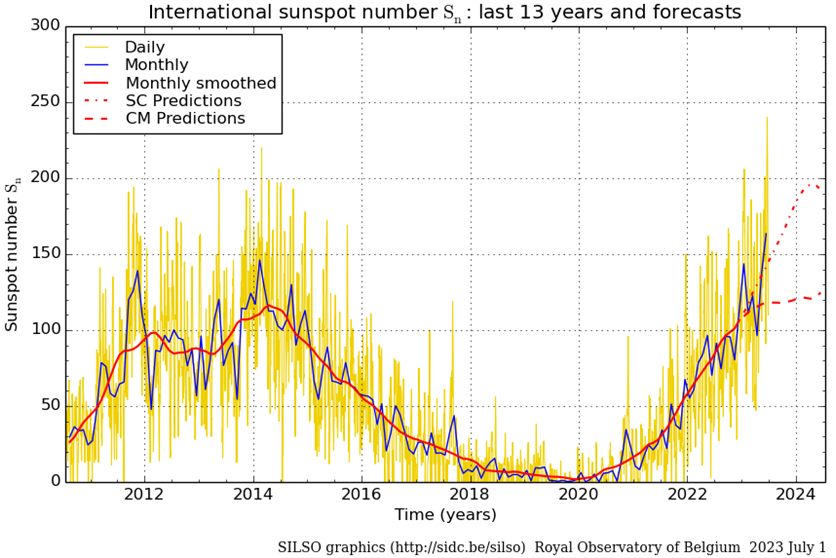From 26 June onwards, a sunspot region quickly developed to become one of the largest sunspot groups of the current solar cycle (SC25) so far. Though still visible on disk, NOAA 13354 is already the second largest region after NOAA 13014 (May 2022), and before NOAA 12786 (November 2020) and NOAA 13153 (November 2022) - See this compilation. Using eclipse glasses, NOAA 13354 was also an easy naked eye object. The SDO/HMI imagery underneath shows the evolution of NOAA 13354 during last week, as well as a zoom on the region.


Despite its size and complexity, NOAA 13354 was initially a relatively quiet region in terms of flare production with just a single M-class flare ("moderate"; 29 June) until 30 June. Then, from 1 July onwards, the region started to grow even further in size and finally created some significant magnetic delta structures (see the STCE SWx classification page). This resulted in a long duration X1 flare peaking at 23:14UTC on 3 July (GOES ; attached). There seems to have been no direct triggering from interaction with preceding eruptive prominence activity, staying well to the northwest of the leading spot and relatively far from the coronal loops overarching NOAA 13354 (clip ; annotated image - SDO magnetogram and AIA 171 difference image). A space weather advisory warning (attached) for Shortwave Fadeout (High Frequency communication or HFCom) was sent to the Civil Aviation (ICAO; PECASUS). HFCom was affected mainly over the Pacific Ocean, Alaska and northeast Siberia (D-RAP). Radio bursts were observed at 2.8, 5.0 and 8.8 GHz (SWPC). The GOES/SUVI extreme ultraviolet images underneath show the flare about 2 hours after its peak in soft-x-rays, on the left at temperatures around 80.000 degrees (SUVI 304) and on the right at temperatures of several millions degrees (SUVI 094). No obvious coronal mass ejection seems to have been associated with this eruption. Another X-class flare from this sunspot region remains possible over the next 2 to 3 days, i.e. until 5-6 July when the region is sufficiently behind the Sun's northwestern limb.

Meanwhile, SILSO -the World Data Center for the production, preservation and dissemination of the international sunspot number- has issued its most recent report with the monthly Provisional International Sunspot Numbers (ISN). With a (provisional!) value of 163.4, June 2023 is now the month with the highest monthly ISN so far this solar cycle. In fact, we have to go back all the way to September 2002 to find a higher monthly sunspot number (187.9). That is more than 20 years ago! A similar story for the daily sunspot number where, on 22 June, the daily sunspot number (provisional!) reached 240. We have to go back to the famous Halloween events in 2003 to find higher values, when 250 was reached on 29 and 30 October. These values confirm that SC25 is shaping up to become stronger than the previous solar cycle 24 - See the STCE SC25 Tracking page. Note that these sunspot numbers are still well below the all-time highs recorded in August 1870 (528 on 26 August) and December 1957 (503 on 24 December).






